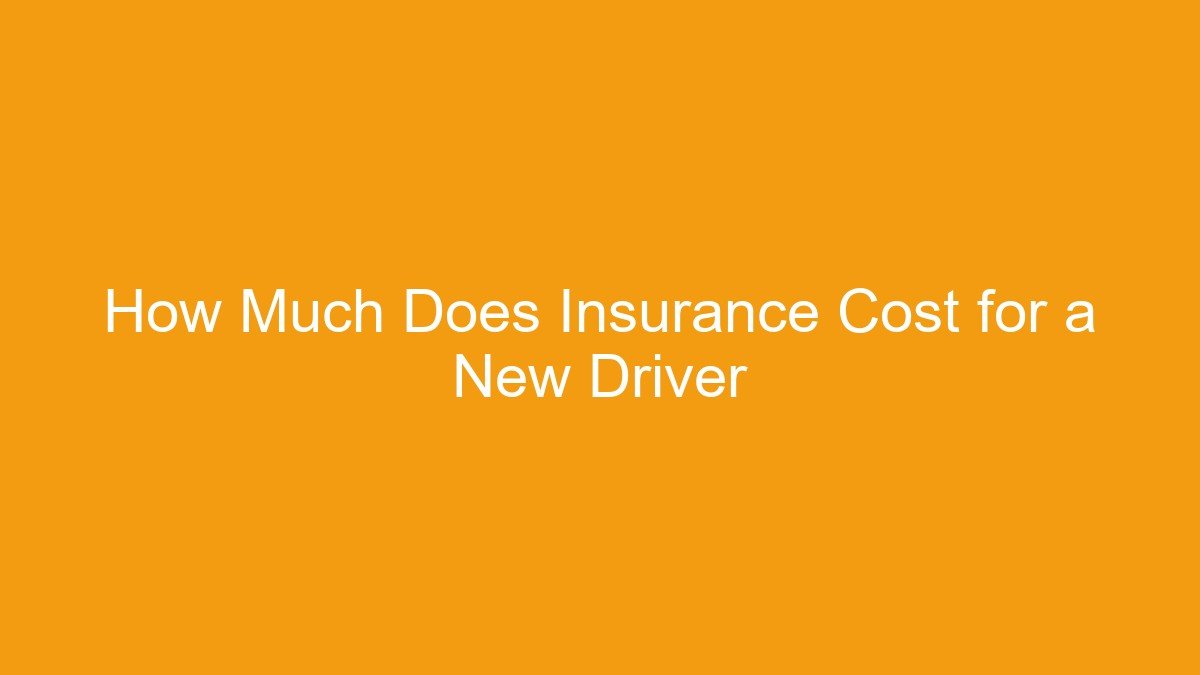
Navigating the world of car insurance can feel like trying to solve a complex puzzle, especially when you’re a new driver or helping one get started. The common wisdom is that insurance for new drivers is expensive – and often, it’s true! But understanding why it’s costly and what you can do to manage those expenses can make all the difference.
This detailed guide will break down everything you need to know about car insurance costs for new drivers, offering practical steps, helpful tips, and common pitfalls to avoid, all in a friendly, easy-to-understand way.
Contents
- How Much Does Car Insurance Cost for a New Driver? Your Guide to Affordable Coverage
- 🛒 Recommended Product
- Why is Car Insurance So Expensive for New Drivers?
- Key Factors That Influence Your New Driver Insurance Cost
- Step-by-Step Guide: How to Find Affordable Car Insurance for a New Driver
- 🛒 Recommended Product
- Top Tips to Lower Insurance Costs for New Drivers
- Common Mistakes New Drivers (and Parents) Make
- What Happens After You Get Your Policy?
- The Bottom Line: Patience and Persistence Pay Off
- 🛒 Recommended Product
- FAQ
How Much Does Car Insurance Cost for a New Driver? Your Guide to Affordable Coverage
Welcome, new driver (or supportive parent)! Getting your driver’s license is a huge milestone, opening up new possibilities and independence. But with that freedom comes responsibility – and the often-daunting task of getting car insurance. You’ve probably heard that insurance for new drivers is generally more expensive, and you’re right. But don’t despair! By the end of this article, you’ll be equipped with the knowledge to navigate the insurance landscape like a pro and find the best possible rates.
🛒 Recommended Product
Let’s dive in!
Why is Car Insurance So Expensive for New Drivers?
Insurance companies are all about risk assessment. They look at data and statistics to predict how likely a driver is to be involved in an accident and file a claim. Unfortunately, new drivers, especially young ones, are statistically considered higher risk. Here’s why:
- Lack of Driving Experience: It’s simple – you haven’t been on the road long enough to build a track record of safe driving. Insurers don’t have personal data on you yet.
- Higher Risk of Accidents: Studies consistently show that teenagers and young adults (under 25) have higher accident rates than older, more experienced drivers. This is due to a combination of factors, including inexperience, riskier driving habits, and slower reaction times in critical situations.
- More Severe Accidents: When new drivers do get into accidents, they tend to be more severe, leading to higher claim payouts for injuries and vehicle damage.
Because of these factors, insurance providers charge higher premiums to offset the increased risk. It’s not personal; it’s just how their models work.
Key Factors That Influence Your New Driver Insurance Cost
While being a new driver is a significant factor, it’s not the only one. Many elements come into play when determining your insurance premiums. Understanding these can help you strategize.
-
The Driver:
- Age: Generally, the younger the driver, the higher the premium. Rates tend to decrease significantly once a driver passes their mid-20s, assuming a clean driving record.
- Gender: Historically, young male drivers faced higher premiums than young female drivers due to statistics indicating higher risk-taking behavior. While this factor is less prominent in some regions and for certain insurers today due to gender-neutral pricing, it can still play a role.
- Driving Record: Even as a new driver, if you receive a speeding ticket shortly after getting your license, your rates will be impacted. A clean driving record is paramount.
- Marital Status: Married individuals are sometimes seen as more stable and responsible, potentially leading to slightly lower rates.
-
The Vehicle:
- Make, Model, and Year: Sporty cars, luxury vehicles, and cars with high repair costs or a high theft rate will cost more to insure. Safer, more common, and less powerful cars are generally cheaper.
- Safety Features: Cars equipped with advanced safety features (e.g., anti-lock brakes, airbags, adaptive cruise control, lane-keeping assist) can sometimes qualify for discounts.
- Value: The more expensive the car, the more it will cost to repair or replace, leading to higher comprehensive and collision premiums.
-
Where You Live:
- Location, Location, Location: Insurance rates vary significantly by state, city, and even zip code. Areas with high accident rates, vehicle theft, or vandalism will have higher premiums. Urban areas are typically more expensive than rural ones.
- Commute: How far you drive to work or school each day can also influence rates.
-
Coverage Types and Limits:
- Minimum vs. Full Coverage: Every state requires a minimum amount of liability insurance, which covers damages you cause to others. If you want protection for your own vehicle (collision and comprehensive), or additional coverage like uninsured motorist or personal injury protection, your premiums will increase. The more coverage you opt for, the higher the cost.
- Coverage Limits: Choosing higher liability limits (e.g., $100,000/$300,000 instead of $25,000/$50,000) offers better protection but also increases the premium.
-
Deductibles:
- Higher Deductible = Lower Premium: Your deductible is the amount you pay out-of-pocket before your insurance kicks in for a claim. Choosing a higher deductible (e.g., $1,000 instead of $500) will lower your monthly or annual premium, but means you’ll pay more if you have an accident.
-
Credit Score (for older new drivers):
- In many states, insurers use a credit-based insurance score to help determine premiums. While new young drivers often don’t have a developed credit history, older new drivers with a good credit score might see lower rates.
Step-by-Step Guide: How to Find Affordable Car Insurance for a New Driver
Finding affordable insurance might seem daunting, but by following a structured approach, you can secure good coverage without breaking the bank.
🛒 Recommended Product
Step 1: Understand Your Needs (and State Requirements)
* Research State Minimums: Start by understanding the minimum liability coverage required in your state. This is the absolute baseline.
* Assess Your Assets: Think about what you need to protect. If you own your car outright and it’s an older, low-value vehicle, you might opt for just liability. If you have a car loan or a newer, more valuable car, full coverage (collision and comprehensive) will likely be required by your lender and is generally a wise choice to protect your investment.
* Consider Additional Coverage: Beyond liability, consider what makes you feel secure. Uninsured/underinsured motorist coverage, medical payments (MedPay), or personal injury protection (PIP) can be very valuable.
Step 2: Gather All Necessary Information
Have the following details ready, as you’ll need them for accurate quotes:
* New Driver’s Information: Full name, date of birth, driver’s license number, date license was issued, any driver’s education certificates.
* Vehicle Information: Year, make, model, VIN (Vehicle Identification Number), current mileage, and primary use (e.g., commuting, pleasure).
* Driving History: Any tickets or accidents (even minor ones), even if it’s a short history.
* Policy Information (if adding to an existing policy): Current policy number, details of other drivers on the policy.
Step 3: Shop Around Extensively!
* This is the MOST important step. Do not just accept the first quote you receive. Insurance rates can vary wildly between companies for the exact same coverage.
* Get Quotes from Multiple Insurers: Contact at least 3-5 different insurance providers. These can be large national companies, smaller regional ones, or even local independent agents who work with several insurers.
* Use Online Comparison Tools: Many websites allow you to enter your information once and receive multiple quotes. While convenient, always verify these directly with the insurer or agent before committing.
* Ensure Apples-to-Apples Comparison: When getting quotes, make sure you are comparing the exact same coverage types, limits, and deductibles. Otherwise, you’re not getting a true comparison.
Step 4: Ask About Every Possible Discount
Discounts are your best friend as a new driver. Don’t be shy; ask about everything! (More on specific discounts below).
Step 5: Consider a Higher Deductible (with caution)
* If you’re confident in your safe driving and have an emergency fund, opting for a higher deductible on collision and comprehensive coverage can significantly lower your premium.
* Caution: Only choose a deductible you can realistically afford to pay out-of-pocket if you need to file a claim.
Step 6: Review and Compare Quotes Carefully
* Don’t just look at the bottom line. Examine the details of each quote: what’s covered, what are the limits, what are the deductibles.
* Read the Fine Print: Understand what each policy offers and any exclusions.
* Ask Questions: If anything is unclear, call the insurer or agent and get clarification.
Top Tips to Lower Insurance Costs for New Drivers
Beyond the steps above, these specific strategies can help you save money:
- Tip 1: Drive Safely and Responsibly. This is the golden rule! A clean driving record is the most powerful tool for lowering your insurance rates over time. Avoid speeding, reckless driving, and accidents at all costs.
- Tip 2: Complete Driver’s Education Courses. Many insurers offer a discount for completing an approved driver’s education course. This demonstrates a commitment to safe driving and can reduce rates.
- Tip 3: Choose the Right Vehicle. As mentioned, a safe, moderately priced, and less powerful car will almost always be cheaper to insure. Think practical, not flashy, for your first car.
- Tip 4: Stay on a Parent’s Policy (if possible). If you live at home, being added to a parent’s existing multi-car policy is almost always cheaper than getting your own separate policy. This allows you to benefit from their driving history, multi-car discounts, and potentially better rates.
- Tip 5: Good Student Discount. If you’re a student with a GPA of 3.0 (B average) or higher, most insurers offer a good student discount. Provide proof of your academic achievement to qualify.
- Tip 6: Consider Telematics/Usage-Based Insurance. Many insurers offer programs (often through a smartphone app or a device plugged into your car) that monitor your driving habits (speed, braking, mileage). Safe drivers can earn significant discounts through these “pay-as-you-you-drive” or “usage-based” programs.
- Tip 7: Pay Your Premiums Annually (if possible). While not always feasible for everyone, paying your entire premium upfront for the year can often save you money compared to monthly installments.
- Tip 8: Bundle Policies. If you’re an older new driver or living independently, combining your car insurance with other policies, like renters or homeowners insurance, with the same company can lead to multi-policy discounts.
Common Mistakes New Drivers (and Parents) Make
Avoid these common pitfalls that can lead to higher costs or inadequate coverage:
- Mistake 1: Not Shopping Around. This bears repeating! Settling for the first quote is almost guaranteed to cost you more money.
- Mistake 2: Only Focusing on the Lowest Premium (Neglecting Coverage). While saving money is important, don’t sacrifice essential coverage to get the cheapest rate. State minimums might not be enough if you cause a serious accident, leaving you financially vulnerable.
- Mistake 3: Hiding a New Driver. Trying to avoid adding a new driver to a household policy is a major mistake and could lead to your claims being denied if that driver is involved in an accident. Always be honest and transparent with your insurer.
- Mistake 4: Getting Full Coverage on an Old, Low-Value Car. If your car is only worth a few thousand dollars, the cost of collision and comprehensive coverage might outweigh its potential payout if totaled. Assess your car’s value against the cost of the coverage.
- Mistake 5: Forgetting to Update Your Policy. If you change vehicles, move, or the new driver’s status changes (e.g., goes to college away from home), always inform your insurance provider. This can affect your rates and ensure you remain properly covered.
What Happens After You Get Your Policy?
Getting insured is just the first step. Here’s what comes next:
- Maintain a Clean Driving Record: This is your best long-term strategy for lower rates. As you gain experience and maintain a claim-free history, your premiums will gradually decrease.
- Regularly Review Your Policy: At least once a year, or when significant life events occur (e.g., getting married, moving, changing jobs, buying a new car), review your coverage and shop around again. Your needs and the market can change.
- Understand Your Policy Documents: Keep your insurance card and know how to access your policy documents. Understand your coverage limits, deductibles, and what to do in case of an accident.
The Bottom Line: Patience and Persistence Pay Off
Yes, car insurance for a new driver can be expensive, but it’s not insurmountable. By understanding the factors at play, being proactive in your search, and committing to safe driving practices, you can significantly reduce those costs over time. Shop around, ask about every discount, and prioritize safety.
🛒 Recommended Product
Don’t let the initial sticker shock deter you. With a little effort, you’ll find the right coverage that fits your budget and keeps you safe on the road. Happy driving!
FAQ
Q. Why is car insurance so expensive for new drivers?
A. New drivers, especially teenagers, are statistically at a much higher risk of getting into accidents due to their lack of experience and developing judgment skills. Insurance companies base premiums on risk, and this elevated risk translates directly into higher costs.
Q. What specific factors influence the cost of insurance for a new driver?
A. Several factors come into play: the driver’s age (younger drivers pay more), the type of vehicle (safer, less powerful, and older cars are often cheaper), location (urban areas with higher theft/accident rates cost more), academic performance (good student discounts), completion of defensive driving courses, and whether they are on their own policy or added to a parent’s existing policy.
Q. Is it cheaper for a new driver to be added to a parent’s policy or get their own?
A. In almost all cases, it is significantly cheaper for a new driver to be added to a parent’s existing auto insurance policy. Parents often have established driving records, multiple vehicle discounts, and better credit scores, which can offset some of the added cost of insuring a new, high-risk driver. A standalone policy for a new driver will be very expensive.
Q. What are some effective ways a new driver can reduce their insurance costs?
A. New drivers can reduce costs by maintaining good grades (many insurers offer a “good student discount”), completing an approved defensive driving or driver education course, choosing a safer and less expensive-to-insure vehicle, and agreeing to a higher deductible (though this means higher out-of-pocket costs after an accident). Maintaining a clean driving record from the start is also crucial.
Q. How much does car insurance typically cost for a new driver?
A. The cost varies widely depending on all the factors mentioned above, but new drivers can expect to pay anywhere from $200 to $400 or more per month, particularly if they are under 20 and on their own policy. On a parent’s policy, the increase might be less, but still substantial, often adding $100-$200+ per month to the family premium.
Q. Does the type of car a new driver drives significantly impact their insurance premium?
A. Absolutely. The vehicle’s make, model, year, safety features, cost of repairs, and theft rates all play a major role. Cars with strong safety ratings, lower horsepower, and less value (meaning cheaper to repair or replace) generally result in lower premiums. Conversely, sports cars, luxury vehicles, or cars with high theft rates will be much more expensive to insure for a new driver.
Q. How long does it take for insurance premiums to start decreasing for a new driver?
A. Generally, premiums start to decrease as a driver gains more experience and demonstrates a clean driving record, typically after 3-5 years without accidents or violations. Rates usually see a more significant drop once a driver turns 25, as statistics show drivers over 25 are considerably less risky than younger drivers.
Related Articles
How Much Does a Tesla Cybertruck Cost
How Much Does a Tesla Cybertruck Cost? Your Ultimate Guide to Pricing & Purchase The Tesla Cybertruck has captured imaginations with its futuristi…
How Much Is a Tesla
How Much Is a Tesla? Unpacking the Cost of Your Dream EV Dreaming of driving a Tesla? You’re not alone! These innovative electric vehicles have …
Affiliate Disclosure: As an Amazon Associate, I earn from qualifying purchases made through links on this site.















